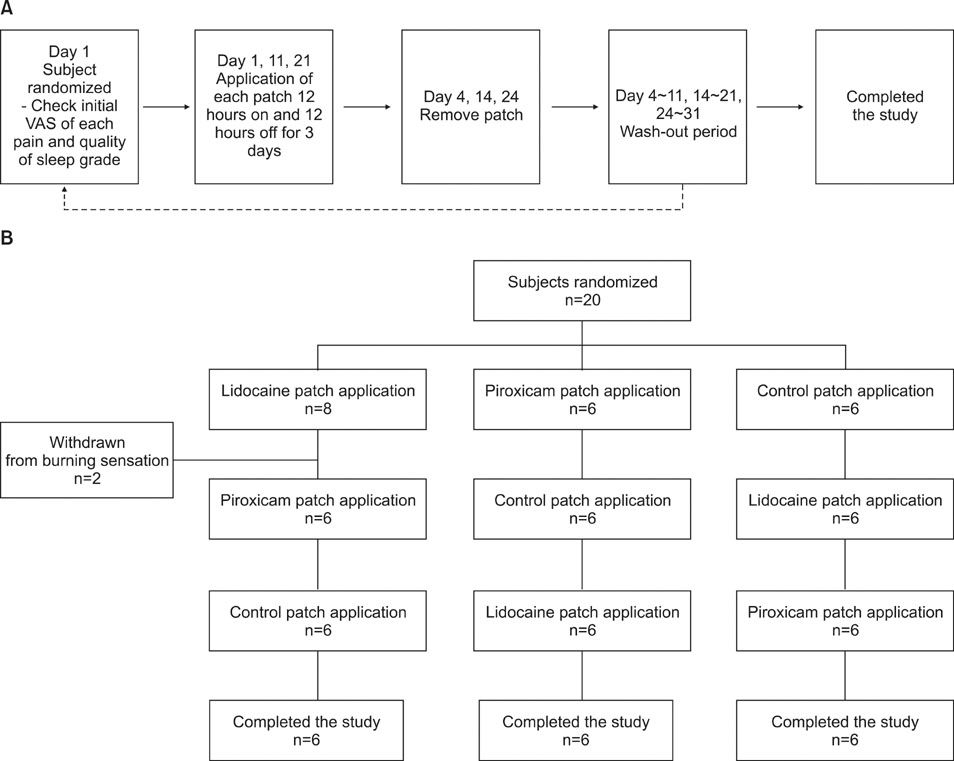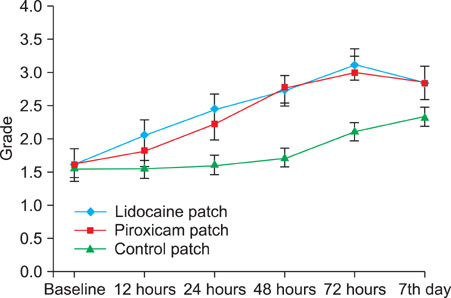Ann Dermatol.
2011 May;23(2):162-169. 10.5021/ad.2011.23.2.162.
Efficacy of Piroxicam Patch Compared to Lidocaine Patch for the Treatment of Postherpetic Neuralgia
- Affiliations
-
- 1Department of Dermatology, Kyungpook National University School of Medicine, Daegu, Korea. dockbs@pusan.ac.kr
- 2Department of Dermatology, Pusan National University School of Medicine, Busan, Korea.
- 3Medical Research Institute, Pusan National University Hospital, Busan, Korea.
- KMID: 2156657
- DOI: http://doi.org/10.5021/ad.2011.23.2.162
Abstract
- BACKGROUND
The lidocaine patch has been effectively used as a first-line therapy to treat neuropathic pain such as postherpetic neuralgia (PHN).
OBJECTIVE
To evaluate the safety and efficacy of the topical piroxicam patch as a treatment option for the treatment of PHN.
METHODS
Eighteen patients completed a 3-session study, applying three different patches (lidocaine, piroxicam and control) in random order. A maximum of three patches were applied to the most painful area for three consecutive days (12 hours on followed by 12 hours off). Each session was conducted at least seven days apart. The changes in visual analog scale (VAS) scores based pain intensity, quality of sleep and adverse effects were recorded.
RESULTS
When compared to the control, both the lidocaine and piroxicam patches significantly reduced the mean VAS scores of pain intensity of all different types. However, the lidocaine patch was better at reducing allodynia, whereas the piroxicam patch was more effective for dull pain. The lidocaine patch worked faster than the piroxicam patch for the response to overall pain relief.
CONCLUSION
The results of this study suggest the use of the piroxicam patch for dull pain and in patients where the lidocaine patch is contraindicated.
Figure
Reference
-
1. Rowbotham MC. Treatment of postherpetic neuralgia. Semin Dermatol. 1992. 11:218–225.2. Eaglstein WH, Katz R, Brown JA. The effects of early corticosteroid therapy on the skin eruption and pain of herpes zoster. JAMA. 1970. 211:1681–1683.
Article3. Park SY, Kim JY, Kim CD, Kim CW, Lee KS. A clinical study on herpes zoster during the last 10-year-period (1994~2003). Korean J Dermatol. 2004. 42:1531–1535.4. Coplan PM, Schmader K, Nikas A, Chan IS, Choo P, Levin MJ, et al. Development of a measure of the burden of pain due to herpes zoster and postherpetic neuralgia for prevention trials: adaptation of the brief pain inventory. J Pain. 2004. 5:344–356.
Article5. Katz J, Cooper EM, Walther RR, Sweeney EW, Dworkin RH. Acute pain in herpes zoster and its impact on health-related quality of life. Clin Infect Dis. 2004. 39:342–348.
Article6. Berger A, Dukes EM, Oster G. Clinical characteristics and economic costs of patients with painful neuropathic disorders. J Pain. 2004. 5:143–149.
Article7. Dworkin RH, White R, O'Connor AB, Baser O, Hawkins K. Healthcare costs of acute and chronic pain associated with a diagnosis of herpes zoster. J Am Geriatr Soc. 2007. 55:1168–1175.
Article8. Watson CP. Watson CP, editor. Medical treatment of postherpetic neuralgia. Herpes zoster and postherpetic neuralgia. 1993. 1st ed. Amsterdam: Elsevier;205–219.9. Alakloby OM, AlJabre SH, Randhawa MA, Alzahrani AJ, AlWunais KM, Bukhari IA. Herpes zoster in eastern Saudi Arabia: clinical presentation and management. J Drugs Dermatol. 2008. 7:457–462.10. Rowbotham MC, Davies PS, Verkempinck C, Galer BS. Lidocaine patch: double-blind controlled study of a new treatment method for post-herpetic neuralgia. Pain. 1996. 65:39–44.
Article11. Kissin I, McDanal J, Xavier AV. Topical lidocaine for relief of superficial pain in postherpetic neuralgia. Neurology. 1989. 39:1132–1133.
Article12. Rowbotham MC, Fields HL. Topical lidocaine reduces pain in post-herpetic neuralgia. Pain. 1989. 38:297–301.
Article13. Meier T, Faust M, Hüppe M, Schmucker P. Reduction of chronic pain for non-postherpetic peripheral neuropathies after topical treatment with a lidocaine patch. Schmerz. 2004. 18:172–178.14. Rowbotham MC, Davies PS, Galer BS. Multicenter, double-blind, vehicle-controlled trial of long term use of lidocaine patches for postherpetic neuralgia [abstract]. Proceedings of the 8th World Congress on Pain. 1996. Seattle: IASP Press;274.15. Kanai A, Kumaki C, Niki Y, Suzuki A, Tazawa T, Okamoto H. Efficacy of a metered-dose 8% lidocaine pump spray for patients with post-herpetic neuralgia. Pain Med. 2009. 10:902–909.
Article16. Csóka G, Balogh E, Marton S, Farkas E, Rácz I. Examination of the polymorphism of piroxicam in connection with the preparation of a new "soft-patch" type pharmaceutical dosage form. Drug Dev Ind Pharm. 1999. 25:813–816.
Article17. Nicholls DS. Treatment of postherpetic neuralgia with topical piroxicam gel. N Z Med J. 1993. 106:233–234.18. Dainty P. Prevention and medical management of postherpetic neuralgia. Br J Hosp Med (Lond). 2008. 69:275–278.
Article19. Cline MA, Ochoa J, Torebjörk HE. Chronic hyperalgesia and skin warming caused by sensitized C nociceptors. Brain. 1989. 112:621–647.
Article20. Tanelian DL, MacIver MB. Analgesic concentrations of lidocaine suppress tonic A-delta and C fiber discharges produced by acute injury. Anesthesiology. 1991. 74:934–936.
Article21. Bowsher D. Watson CP, editor. Sensory change in postherpetic neuralgia. Herpes zoster and postherpetic neuralgia. 1993. 1st ed. Amsterdam: Elsevier;97–107.22. Haanpää M, Laippala P, Nurmikko T. Pain and somatosensory dysfunction in acute herpes zoster. Clin J Pain. 1999. 15:78–84.
Article23. Pappagallo M, Oaklander AL, Quatrano-Piacentini AL, Clark MR, Raja SN. Heterogenous patterns of sensory dysfunction in postherpetic neuralgia suggest multiple pathophysiologic mechanisms. Anesthesiology. 2000. 92:691–698.
Article24. Devor M, Govrin-Lippmann R, Angelides K. Na+ channel immunolocalization in peripheral mammalian axons and changes following nerve injury and neuroma formation. J Neurosci. 1993. 13:1976–1992.
Article25. Oaklander AL. Mechanisms of pain and itch caused by herpes zoster (shingles). J Pain. 2008. 9:S10–S18.
Article26. Tyring SK. Management of herpes zoster and postherpetic neuralgia. J Am Acad Dermatol. 2007. 57:S136–S142.
Article27. Devers A, Galer BS. Topical lidocaine patch relieves a variety of neuropathic pain conditions: an open-label study. Clin J Pain. 2000. 16:205–208.
Article28. Furst DE, Munster T. Katzung BG, editor. Nonsteroidal anti-inflammatory drugs, disease-modifying antirheumatic drugs, nonopioid analgesics, & drugs used in gout. Basic and clinical pharmacology. 2001. 8th ed. New York: McGraw-Hill;596–623.
- Full Text Links
- Actions
-
Cited
- CITED
-
- Close
- Share
- Similar articles
-
- A Study on the Effect of Topical 5% Lidocaine Patches on Postherpetic Neuralgia
- The Effect of Fentanyl Patch in the Treatment of Intractable Postherpetic Neuralgia
- An experience of increased pain in patient with postherpetic neuralgia who had skin excision: A case report
- Fixed Drug Eruption Caused by Piroxicam
- Study on Clinical Efficacy of Pixoicam Pathch ( Trast(r) ) in Patients with Rheumatoid Arthritis






